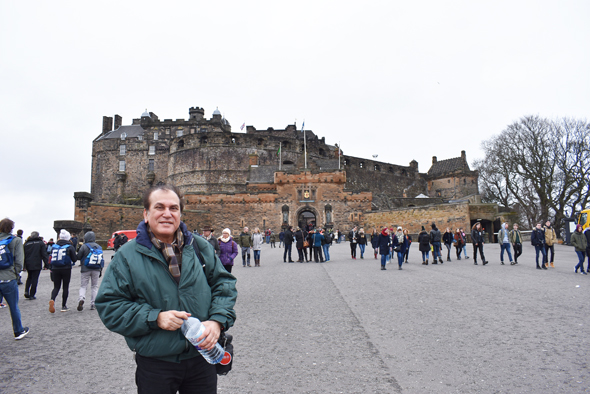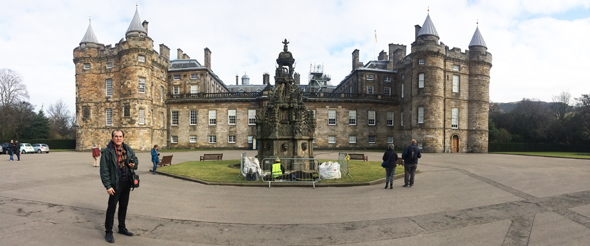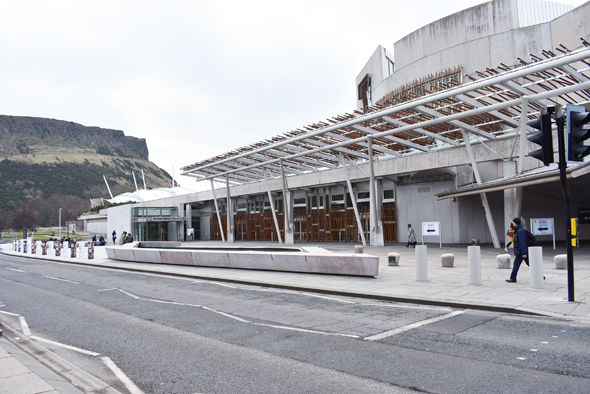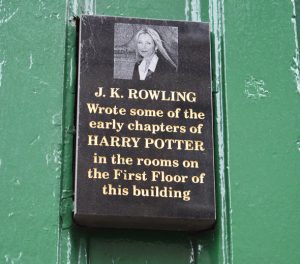History and Literature Beckon Around Every Corner of Edinburgh

Edinburgh Castle dominates the city center on the east side. The Royal Mile runs from its front gate all the way to the Holyroodhouse Palace on the west side.
By Jawahar Malhotra
EDINBURGH, SCOTLAND: Edinburgh is one of the UNESCO World Heritage Cities and there is so much history around you (“101 places in Edinburgh” to see, the placards say) it naturally oozes into you. You get a good glimpse of English history – the kind I learnt, like most other Indian kids in school – when you walk around Edinburgh. The massive old structures made of sandstone have darkened with hundreds of years of accumulated grime, mildew and most recently air pollution and you have an impulse to power wash them into cleanliness!

The Holyrood House Palace is the official palace of the Queen though her personal palace, Balmoral, is further to the north of Dundee and west of Aberdeen.
On the east side of town, east of North Bridge Street and the central Waverly Train station – the city is dominated by Edinburgh Castle on a hill, which is really a fort that was impenetrable during many wars between the Scotts and the English. On the plaza in front of the fort, there is a placard by the cross commemorating the Heroes of the 78th Highlanders during the Indian Mutiny of 1857-58 in Lucknow and it especially talks about the elephant that was brought to Scotland in 1839 and became their mascot in 1839 “often drinking beer”!
The west end of the city is dominated by Calton Hill and the panoramic views of the city and the Firth of Forth estuary. It has numerous monuments built in the Athenian style (versus Greco-Roman in other European capitals) and the old “New Parliament” building. There is a new cemetery which is hedged in between a road and housing on the other side, not far from the 15th century Holyroodhouse Palace, the official working palace of the Royals.

The stylishly modern 5 year-old Scottish Parliament building is situated across the street from the Holyroodhouse Palace.
Facing the Palace is the five-year-old Scottish Parliament building and in the front plaza, two women were perched on a stone ledge, knitting away without any concerns! The grounds and the front formal rooms of the Palace are open to visitors as is the Abbey whose roof finally collapsed for the last (of three) time in 1872. On most days you are able to get a free visitor’s pass and see the proceedings of the session of Parliament from the seats in the balcony.
Edinburgh is fascinating with all the references in the city to academic, literary and other famous figures among its inhabitants. Adam Smith, a social philosopher and economist who wrote “The Wealth of Nations” is immortalized with a bronze statue on the Royal Mile.Across on the other end of the Mile, on Calton Hill, there is a hilltop monument to 19th century philosopher Dugald Stewart, and this was the model for the pillared rotunda monument further down the road near the new cemetery to Scotland’s famous 19th century poet Robert Burns who lived in Edinburgh for two years.
In the center of town is the tall Scott spire monument to Sir Walter Scott, a 19th century poet and author of The Waverly Novels.
Down from there is Deacon Brodie’s Tavern with a painted description of how his baseness inspired another Edinburgh famous son, Robert Louis Stevenson (of Treasure Island fame) to write “Dr. Jekyll & Mr. Hyde”. Stevenson’s house is north of the city center. Another famous figure with a tavern to his name is Arthur Conan Doyle, the famous author of Sherlock Holmes.

A plaque outside the Black Medicine Coffee Co. heralds how J.K. Rowling of Harry Potter fame wrote in its rooms.
Andrew Carnegie, the steel magnate who made his fortune in the US, was born just north of the city in Dumfernline and there is a bust to him in the Central Library (he donated to 2811 libraries in his lifetime).
Then there is the more curious story of Greyfriars Bobby, a dog who waited over his master John Gray’s grave till he himself died of old age at 16. Bobby’s gravestone is featured prominently at the graveyard entrance gate.
It’s safe to say that Edinburghers love to read, even the homeless man on the street had a thick volume in his lap. And the most famous modern writer must be J.K. Rowling who has plaques to her frequent use of local coffee shops like The Elephant House which boasts that is was the birthplace of Harry Potter and further up North Bridge Street, the Black Medicine Coffee Co. claims that Rowling wrote some of her early chapters there.
